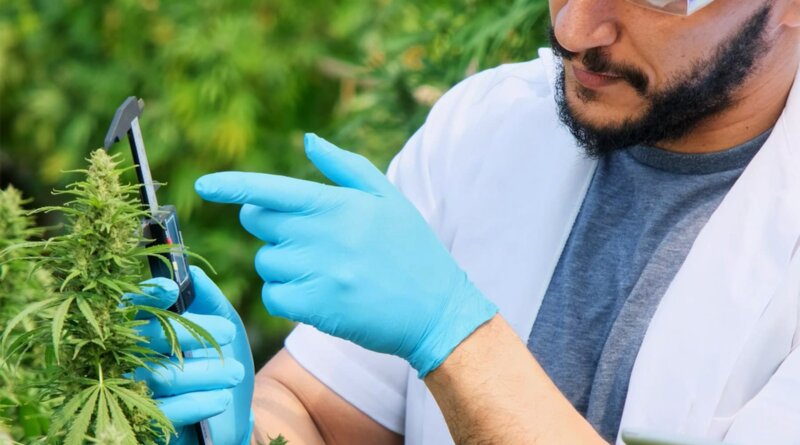Is This a New Era of Medical Marijuana Breakthroughs?
April 20, 2023 – Maureen Kennedy struggled with sleep problems for more than 30 years. She tried Excedrin PM, trazodone, and Ambien. That last one worked, but her doctor cut her off, worried the drug might increase the 82-year-old’s risk of a dangerous fall.
“I asked my doctor about cannabis for sleep,” said Kennedy, who lives in Colorado where marijuana – or cannabis – is legal. “He said ‘absolutely try it,’ but he had no advice as to which kind or how much. Fortunately, I’m an information gatherer, so I worked it out myself.”
Kennedy tried smoking cannabis, vaping THC oils, and eating infused gummies but had bad reactions. Then her son introduced her to a friend who was whipping up batches of a cannabis preparation known as Rick Simpson Oil (in his kitchen), and he shared some with her. Bliss ensued.
Now she buys the oil at a nearby dispensary and swallows a rice-sized drop two hours before bed. “It keeps me asleep all night,” she said.
Kennedy is far from the only one self-medicating with cannabis. Hop on Facebook and search for “Medicinal Cannabis Support Group” to meet 3,000 others just like her: A woman who credits cannabis for helping with her Parkinson’s symptoms, somebody’s nana who used cannabis to relieve years of chronic pain, and a child whose terrifying seizures were calmed by the Rick Simpson Oil (also said to cure cancer).
The problem: Nobody really knows from a clinical research perspective how, or even if, these “therapies” actually work. For years, regulatory barriers and funding biases have impeded research into cannabis’s therapeutic effects, creating massive gaps in our knowledge of its potential to treat disease.
That’s changing, based on a new law signed by President Joe Biden last December. The Medical Marijuana and Cannabidiol Research Expansion Act (a rare example of bipartisan legislation) aims to speed up research on the health benefits of cannabis and support open communication between doctors and patients on cannabis’s potential benefits and harms.
It works by rolling back federal restrictions on marijuana research and speeding up the application process. (The U.S. attorney general must now approve new applications for cannabis research within 60 days.) What’s more, under the new law, the government must maintain an “adequate and uninterrupted supply of marijuana” for research use.
Even before the new law, a growing number of studies were underway to see how cannabis might help with an array of maladies, from post-operative nausea to PTSD to migraines and all manner of anxiety and pain. Each takes years to complete. Despite the barriers, the number of cannabis researchers in the U.S. has risen sharply over the past decade, accounting for about 72% of Schedule I research registrations (589 out of 808) between 2014 and 2020.
At the National Institutes of Health, “there is more realization that we need to understand the potential medical benefits,” said David Shurtleff, PhD, deputy director of the NIH’s National Center for Complementary and Integrative Health, and an expert panel member for the cannabis-research resource STEM. Efforts, including the new law, are in progress to help scientists clear the hurdles to doing research, Shurtleff said.
There’s good reason for those efforts. The tide of sentiment against cannabis has turned. According to a November poll from Pew Research, 88% of U.S. adults believe cannabis should be legalized. The Marijuana Policy Project estimated that, as of 2021, 5.4 million people were seeking cannabis cures with or without their doctors’ advice. The plant has now been legalized in most states for medicinal or recreational use, or both.
“The states that have approved use of medical marijuana have really pushed us to catch up. We’re behind the curve,” Shurtleff said. “As a public health research organization, it’s our obligation to study and determine whether these cannabinoids are safe and effective.”
The new law is meant to help scientists do just that. But don’t expect breakthrough treatments overnight, he said. It takes many steps for research to reach clinical trials, the kind of formal studies needed to test a medical intervention. “The average time to develop a medication is about 10 years,” Shurtleff said.
Bottom line: A large ship is finally leaving port, but that happens slowly.
Still an Outlaw Plant
Among the major remaining obstacles: The Drug Enforcement Administration still classifies cannabis as a “Schedule I” drug, in the same league as LSD, heroin, ecstasy, and cocaine, and with “no known medical benefit.”
Biden has directed the DEA to reconsider that designation, and a House Republican has submitted a bill to make cannabis a “Schedule III” drug (one with a low to moderate risk of dependency), but those attempts could take a while. Shane Pennington, a Denver attorney who tracks cannabis legislation, pegs the average length of a rescheduling a drug at 9 years.
Until that’s changed, cannabis will remain an outlaw plant, and research will face obstacles.
“At the National Institutes of Health, people didn’t want to do cannabis research because it’s so darn hard to get involved in,” said John Williamson, PhD, senior director of research at the Institute of Cannabis Research, at Colorado State University, Pueblo. “It takes a couple of years just to get licensed, and for a young researcher, a couple of years waiting around can ruin your career.”
A 2017 report from the National Academies of Sciences, Engineering, and Medicine cites several barriers, including “a series of review processes” by a long list of potential arbiters, from federal agencies to state offices and medical examiners, to the researcher’s home institution and potential funders. Among other challenges: a shortage of lab-quality cannabis, handling and storage restrictions, and a lack of standard dosing and administration techniques.
“Sometimes, studies won’t get underway until a year after the proposal is submitted,” said Ziva Cooper, PhD, director of the UCLA Center for Cannabis and Cannabinoids, and co-author of the report. “Then you have to wait for results to come in. It takes years before you have results.”
An emphasis on drug abuse and adverse effects has made funding an issue as well. “For decades, federal funding has been given to studies looking primarily at the negative effects, not potentially positive ones,” Cooper said.
How the New Law Helps
Cooper describes the new law as an “incremental step” toward freeing up researchers. G. Malik Burnett, MD, an addiction medicine specialist at the University of Maryland Medical Center, cites two positive impacts.
First, research institutions will no longer jeopardize their federal funding because they are studying medicinal uses for cannabis. It also relieves the threat that researchers could lose their medical licenses for dabbling in “dangerous” cannabis.
Second, the legislation expressly allows doctors to discuss cannabis with their patients. That can help: A 2021 study in the Journal of Cannabis Research noted that only 24% of patients who use medical cannabis medicine got advice from their doctor; 64% went by their own experience.
The evidence on health uses of cannabis is mostly from other countries. U.S. health care providers can now help patients tap into more established health benefits for such conditions as wasting diseases, weight loss, some forms of epilepsy, and chronic pain. But they will be relying on research mostly from Israel, Uruguay, and the Czech Republic.
The new law encourages more home-grown research and product. Formerly, the University of Mississippi was the only institution licensed to grow cannabis for research – a significant bottleneck. Six more sources have now been approved, according to Cooper. And the law requires that the U.S. Attorney General’s Office give a thumbs-up or down on new research crops within 60 days.
Protecting Public Health
Change is happening, but perhaps not quickly enough for the millions of Americans who stand to benefit from more cannabis research.
“It may not be possible to ever know the amount of suffering caused by schedule I,” said Ben Lightburn, co-founder and CEO of Filament Health, a natural-drug development company based in Vancouver, British Columbia. “How many epileptic children might have been helped or even saved from death had Epidiolex [a cannabis-derived anti-seizure drug] been commercialized years earlier than 2018? How many people with depression and PTSD may have been helped or saved from death?”
The flip side – free experimentation with cannabis – has risks as well, especially when patients turn to Dr. Facebook. The Journal of General Internal Medicine found that fewer than 5% of claims made for cannabis on the internet were true; more than 80% were patently false.
Consequences can be dire. A study published this year in the Journal of the American Geriatrics Society found that cannabis-related ER visits among California adults 65 and up went from 366 in 2005 to more than 12,000 in 2019. Frequent use of cannabis has been linked to increased risk of psychosis or schizophrenia in some users, and using it during pregnancy may increase the risk of complications. Cannabis use disorder is also on the rise, in particular among older and non-white adolescents.
The new legislation may help replace speculation and self-experimentation with hard science. But it’s starting from behind: Scientists aren’t testing the forms of cannabis already on sale at thousands of dispensaries across the U.S.
“Because the federal government continues to largely restrict study of the cannabis products available in state-legal markets, consumers face limited understanding of its risks and benefits,” said Matthew Lowe, PhD, the research director at Realm of Caring, a cannabis research nonprofit.
Pennington cites another hurdle. “Who is waiting on research, when everybody is already using it? There’s zero incentive for drug companies to pay for this expensive research when cannabis is already out there.”
Yes, there’s money to be made; for a life-saving drug, a company can charge $80,000 a month for a prescription. But it costs between $314 million and $2.8 billion to develop a new drug, and it’s hard to compete with an $8 loose joint when that guy on Facebook – or maybe your mom – tells you that cannabis can cure almost anything. So why place expensive bets on FDA approval when word-of-mouth rules the day?
Which brings us back to the fundamental problem: Cannabis is a Schedule I drug, and it’s also being used to treat all sorts of conditions.
“If cannabis is removed as a Schedule I substance, research on the health benefits would flourish,” Lowe said. “Policymakers would be influenced by evidence-based research rather than ignorance-driven experimentation.”
Of course, many are not willing to wait, relying on unscientific health histories and a contingent of health care providers taking the lead on education.
Take 41-year-old Jennifer Axcell from Denver, who became addicted to opioids after she had a serious car accident. She weaned herself off the prescription drugs with cannabis. The pain lessened, but she was stoned all the time. So she found the right nurse to advise her. The experience inspired Axcell to help launch Leaf411, a cannabis nurse hotline.
“Research is a three-pronged process,” Axcell said. “The first is double-blind placebo-based study – the gold standard for medical research. But the other two are what the clinicians are learning from treating hundreds of patients, and what the patients themselves are learning.”




